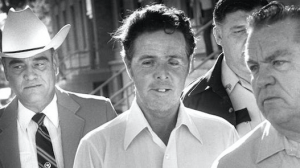Imagine coming home from a long day of work from your main job, only to instantly begin work again on developing an invention that could change the outcome of World War II. Countless hours spent in a room in your home designated specifically for inventing, motivated by the idea of helping the people you left behind in your hometown. You strive in your free time to create something that would not only show your loyalty to the United States but would also help defeat the Nazis. Nothing could stop you, except maybe your reputation and gender. And this was the case for the famous actress Hedy Lamarr, the woman who dedicated her efforts to inventing the concept of spread spectrum. No one thought she would be capable of helping to create a technology that is still used in wireless communications to this day. But Lamarr set out to help those with her same beliefs who were suffering because of this war.1

Hedy Lamarr was undoubtedly beautiful, and was even credited with being the most beautiful woman in the world, but when she wasn’t in front of the flashing lights of fame, she was an amateur scientist.2 Hedy Lamarr was so much more than her beauty. She was intelligent and creative. After years of success in her acting career, she became actively involved in the world of science and technology. Lamarr had a racy past, which included her becoming known as a sex symbol in the film industry, and countless scandals that caused her other amazing talents and inventions to be hidden in the shadow of her limelight. Her growing wealth and Austrian past gave her the motive to contribute help to those who were suffering in Europe. As any successful actress, Hedy Lamarr attended many parties, but little did she know that one of these parties would be crucial in commencing the invention that has changed the world.3
The Japanese attack on Pearl Harbor in December 1941 got Lamarr involved with selling war bonds and volunteering in United Service Organization clubs to help the country as much as possible. Hedy was great at selling war bonds, even selling up to $7 million in one night; but Lamarr knew she could do more.4 This resulted in her beginning to ponder the ideas of her greatest invention. Then, one night as Lamarr attended another one of her Hollywood parties, she met George Antheil, a music composer for Hollywood films. Together, the two would turn Lamarr’s ideas into reality.5 After spending the whole night discussing their admiration for inventing and interest in assisting in the war, the two built the foundations of an invention that would possibly assist the Navy in attacking enemy ships. Lamarr even considered leaving Hollywood to dedicate her full energy to inventing, by joining the National Inventor’s Council, but was dissuaded by Antheil. She then decided to stay in Hollywood, where she could boost public morale through her films and work on her inventions in her free time. Despite Lamarr’s busy schedule, she was able to work with Antheil to begin developing her idea. Antheil’s previous knowledge in having once composed a piece that required sixteen synchronized player pianos assisted in executing Lamarr’s idea.
Lamarr was largely motivated by her Jewish roots. She wanted to bring her mother to the United States, which was nearly impossible at the time. The trip to cross the Atlantic was extremely dangerous, as Nazi submarines were blowing up any ships that carried refugees trying to flee Europe, which only fueled Lamarr’s desire to assist in ending the war. With her extensive knowledge of weapons used in this war, due to her previous relationship with Fritz Mandl, a munitions manufacturer who created weapons and worked closely with Nazis, Lamarr was able to find a problem that needed a solution. The cause that Lamarr sought to fix was the waste warships went through as they shot torpedoes in a general direction before actually hitting the enemy.6

Lamarr’s plan was to invent a radio-controlled missile that contained an anti-jamming device. The idea of a radio-controlled missile was genius for the time, as it would be able to adjust to a moving target. The only issue with this was that the radio frequency controlling the missile could be easily obstructed by the enemy.7 The process that would fix the issue with a regular radio-controlled missile would soon be known as “Frequency Hopping.” This idea of frequency hopping allows a message to be broadcast over a series of radio frequencies and a receiver hopping from frequency to frequency simultaneously is used to pick up the message. Any eavesdroppers would not be able to hear the full message and those attempting to stop the message (also known as jammers) would only be able to knock out a few pieces, allowing the full message to still get through.
Lamarr and Antheil’s invention was genius. If applied correctly, this invention could have cut the time spent at war and possibly saved millions.8 After a collaborative effort, the two sent their description of the system to the National Inventors Council in order to receive a patent. The patent’s design actually used paper rolls similar to piano rolls to synchronize the jumps between the transmitter and the receiver. There are also 88 proposed frequencies matching the number of keys to a piano. There is little doubt that the invention’s design was heavily influenced by Antheil’s involvement in music.9
The patent was granted about one year later and was sent off to Washington to possibly be considered for use in war. However, Lamarr was told that the device was unworkable and that her efforts should remain focused more on entertaining the troops and selling war bonds.10 The efficiency of their invention was overshadowed by the roles the two played in the public. The Navy didn’t believe an actress and a concert pianist could create something of any use to the war. They also considered the mechanism to be too bulky to attach to a torpedo, due to their ignorance when reading the patent and seeing the words “player piano,” which led them to believe that the two wanted to attach a player piano to a missile! This ignorance resulted in the patent collecting dust for twenty years, until three years after its expiration.11

The design was then used for a basic secure military communication. Sadly, this was not until the patent between the two had expired, resulting in neither Lamarr nor Antheil receiving a cent or any credit for their hard work. Between the years of 1945 to 2012, the patent was cited at least sixty-two times, proving it to be far from unworkable, both commercially and militarily. It was not until 1997 that Lamarr and Antheil would receive their official recognition from Electronic Frontier Foundation.12
Hedy Lamarr and George Antheil’s invention was ahead of its time. But it leaves us with the question as to what may have been different if the two had not been dismissed on account of their careers? Maybe if Lamarr had recognized her own worth as well as the worth of her invention, she would have fought for its use in the military rather than passively sitting back and allowing it to collect dust. From the face that inspired Walt Disney’s first princess, Snow White, to the brains behind the scientific concept of spread spectrum, Hedy Lamarr is a remarkable woman. And due to the efforts of Lamarr and Antheil, the concept of “frequency hopping” can now be found at the tips of your fingers, as it serves as the foundational technology in Wi-Fi, Bluetooth, and GPS.13
- Women in World History: A Biographical Encyclopedia, 2002, s.v. “Lamarr, Hedy (1913-2000),” by John Haag. ↵
- Cathaleen Chen, “Hedy Lamarr: Actress by day, tech inventor by night; Heddy Lamarr was honored with a Google Doodle. It turns out, the famous actress was also quite the inventor,” The Christian Science Monitor, November 9, 2015. ↵
- Women in World History: A Biographical Encyclopedia, 2002, s.v. “Lamarr, Hedy (1913-2000),” by John Haag. ↵
- Women in World History: A Biographical Encyclopedia, 2002, s.v. “Lamarr, Hedy (1913-2000),” by John Haag. ↵
- Women in World History: A Biographical Encyclopedia, 2002, s.v. “Lamarr, Hedy (1913-2000),” by John Haag. ↵
- Anna Diamond, “Hollywood’s Secret Weapon: A new documentary, Bombshell: The Hedy Lamarr Story, unearths the movie star’s World War II invention, an ingenious forerunner of high-tech communications. Director Alexandra Dean loops us in,” Smithsonian 26 (2017). ↵
- Sandra Hall, “Inside Hedy Lamarr’s secret life as a wartime inventor,” The Age (Melbourne, Australia), March 1, 2018. ↵
- Interestingly, the technology of “frequency hopping” would only catch on twenty to thirty years after the invention’s creation in 1941. ↵
- Gale Virtual Reference Library, 2007, s.v. “Lamarr Hedy”,227. ↵
- Pamela Hutchinson, “Hedy Lamarr: Stealing Beauty,” Sight & Sound 28, no.4 (2018): 42. ↵
- Fleming Meeks, “I guess they just take and forget about a person,” Forbes 145, no. 10 (1990): 137. ↵
- Pamela Hutchinson, “Hedy Lamarr: Stealing Beauty,” Sight & Sound 28, no.4 (2018): 42. ↵
- Richard Rhodes, “HEDY’S FOLLY: The Life and Breakthrough Inventions of Hedy Lamarr, the Most Beautiful Woman in the World,” Kirkus Reviews 79, no. 19 (2011): 1796-1797. ↵



67 comments
Sara Guerrero
This article caught my attention quickly becuase of a beautiful actress who went beyond what other’s believed she could only do which was to sell war bonds and Hedy was not afraid to show her potential. It dissapointing that her work and George Antheil’s invention was not taken by the government it definitely raises the question of “what if?.” I was unaware of frequency hopping found in wifi, bluetooth, and GPS which is something we all use so much. It’s sad that I am learning this now and may others are probably unaware of the people behind this technology.
Samuel Vega
I had no idea who Hedy Lamarr was. The article was enjoyable and light after reading so many of the other depressing articles from the Great War Age. What a talented individual! It is disappointing that her inventions were not recognized in the 40s because she was seen as an actress and a woman; therefore, she could not have the intelligence to develop anything like “frequency hopping.” I am glad to see the serotyping was removed and she received credit for her contributions. This is a good reading during Women’s History month.
Alin Bocardo Felix
The line that reads that someone would be capable of doing what was listed without any interruptions, “except maybe your reputation and gender” is still very relevant. Hedy Lamarr proved to be a person of her morals, despite the fame and ‘easy’ life she carries simply because of her looks, she strove to make the world a better place and now is a role model for many women. Sometimes society is the issue in the first place, and then people come out saying so, without realizing we are all society. Sometimes it takes one person so set a milestone for the rest of us, sometimes it takes ten because of our gender.
Averie Mendez
I had never heard of Hedy Lamarr prior to reading this article. However, I love articles that emphasize woman as three dimensional people rather than just filler characters, filling a mold and playing a part. Hedy Lamarr was Jewish woman who was gorgeous, brilliant and promiscuous. She was beautiful enough to inspire Snow White, and she was intelligent enough to create radio-controlled missiles. Women are multi-faceted human beings.
Rebeca Escobar
It’s so nice to hear about women like this during this era, especially when they break the brains and beauty stereotype. I feel like Hedys story isn’t as well known and recognized, and it definitely should be! I’m sad her work wasn’t really taken seriously but I’m happy she was a defining female figure in this field.
Ruby Wynn
This is an excellent article. I had heard of Hedy Lamarr, and knew that she was an actress and inventor, but did not know what she invented. It is unfortunate that the military did not take her invention more seriously. I wonder how the war would have gone if her invention was used. She is partly responsible for us having wifi and GPS today.
Priscilla Reyes
I had a great time reading about the original Snow White! I was impressed by her abilities of selling goods, because it’s something I wish I was good at. I was curious to learn more about her acting career although the article was perfect the way it was written. My favorite piece of information was the ties between ending war and bringing her mother to her side. It is amazing to see the impact of war and oceanic trips in the lives of many.
Thomas Fraire
Your intro was really cool. You hit all the point you expected to genuinely foretell what you would cover later in your article. I think this is an unfathomable story, one that was required in a period where ladies were not found in research fields as broadly as they are currently. She had such a large number of solid credits to her. She was keen, excellent, and liberal. What a symbol!
Noah Wesolowski
Hedy Lamarr while I have heard the name before I only know that she was an actor I did not have any idea that she was an amateur scientist nor that she helped create the concept of spread spectrum. It is fascinating to know that she was constantly trying to help the war effort by selling bonds and anyone else would have been fine just selling them but she decided to do more to help the war.
Emily Velazquez
I cannot believe it took so long for them to receive recognition for the invention they created just because they were an actress and concert pianist. They were not given enough credit at the right time and I’m glad this article does give them that credit. I think this goes back to that lesson, “don’t judge a book by its cover”, because this young lady, although known for looks, was very intelligent and invented something that is widely used to this day.